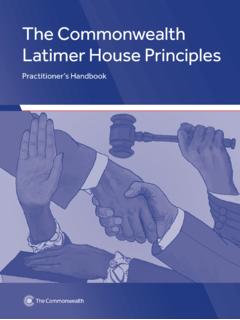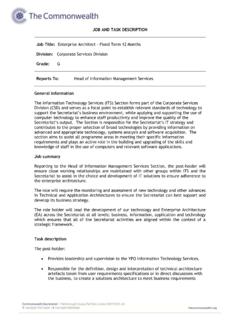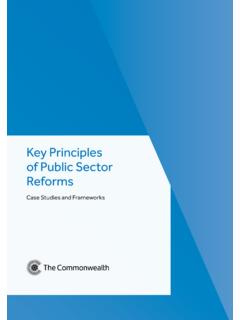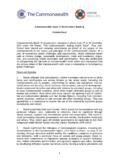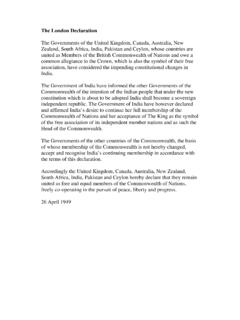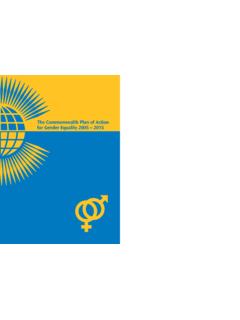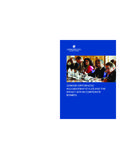Transcription of Evaluation of the Commonwealth Secretariat’s …
1 FINAL REPORT Evaluation of the Commonwealth secretariat s strategic plan (2013/14 2016/17) An independent Evaluation carried out by the Centre for International Development and Training (CIDT) at the University of Wolverhampton, United Kingdom 27 January 2017 iii Contents Acknowledgements .. iv Acronyms and Abbreviations .. v Executive summary .. ix Overview .. ix Main findings .. ix Lessons .. xv Recommendations .. xvi 1. Introduction .. 1 Background .. 1 Purpose of this Evaluation .. 1 2. Methodology .. 3 Summary of methods used .. 3 Limitations .. 4 3. Findings: Relevance .. 6 strategic plan development .. 6 strategic plan design .. 9 Alignment to broader initiatives .. 16 Organisational reform and restructuring .. 19 4. Findings: Effectiveness and efficiency .. 25 Results-based management (RBM) system.
2 25 Gender mainstreaming efforts .. 38 Operations in support of SP delivery .. 42 Partnerships and collaboration .. 50 5. Findings: Results and benefits to member countries .. 56 Satisfaction levels and perceived comparative advantages .. 56 Results of strategic plan implementation .. 58 6. Findings: Sustainability .. 70 Examples of sustainable work and opportunities for sustainability .. 70 Models and enabling factors of sustainability .. 73 Risks/threats to sustainability .. 74 Recommendations for sustainability .. 76 7. Key lessons 78 8. Recommendations .. 81 9. Conclusion .. 86 Annex A Details of methodology .. 87 Annex B List of Respondents .. 90 Annex C List of documents provided to support the Evaluation .. 104 Annex D Field visit summaries .. 111 Annex E Analysis of internal 120 iv Acknowledgements We would like to thank the many people who have actively guided and supported this Evaluation .
3 First, we acknowledge the strategic Planning and Evaluation Division (SPED) at the Commonwealth secretariat particularly, Nabeel Goheer (Director), Evelyn Ogwal Pederson (Adviser/Head of Evaluation ), Norma MacIsaac (Adviser/Head of Planning) and Katherine Marshall Kissoon (RBM Officer) and Emily Rhoades (Team Administrator). Their clear guidance, proactive communications, and timely support enabled the smooth implementation of the Evaluation . We extend special thanks to Ms Rhoades, as well as Ms Pedersen, for always making themselves available to answer questions and share requested documents, as well as for providing superb support in the scheduling and logistics of the staff interviews and Field Missions. Second, we would like to thank all the internal and external stakeholders, who willingly and openly shared their opinions and experiences with us as respondents in the survey.
4 This includes: a wide range of Commonwealth secretariat staff at the London Headquarters office; long-term experts, consultants and former staff; partners and beneficiaries within member countries; representatives of Commonwealth organisations; and development partners, such as the European Commission and High Commissions at the country level. Finally, we appreciate and recognise the efforts of past evaluators and the individuals involved in preparing the various reports and other resources that were consulted as part of the Document Review. These served as an important source of information, to complement the primary data collection that was conducted for this Evaluation . Ella Haruna (Team Leader) and Kimberly Kane (Principle Evaluator), CIDT v Acronyms and Abbreviations ARR Annual Results Reports ARTEMIS Activity Results Tracking and Expenditure Management System BRICS Major emerging national economies.
5 Brazil, Russia, India, China, South Africa BTOR Back-to-Office Report CARICOM Caribbean Community CCASS Computerised Case Administration System CCP Commonwealth Connects Programme CFTC Commonwealth Fund for Technical Co-operation CFNHRI Commonwealth Forum of National Human Rights Institutions CHOGM Commonwealth Heads of Government Meeting CIDT Centre for International Development and Training CMAG Commonwealth Ministerial Action Group CMDF Commonwealth Media Development Fund COG Commonwealth Observer Group COMM Communications Division COMESA Common Market for Eastern and Southern Africa CSD Corporate Services Division CS-DRMS Commonwealth secretariat s Debt Recording and Management System CYP Commonwealth Youth Programme (fund) DFAT Australian Department of Foreign Affairs and Trade DFID UK Department for International Development DMU Debt Management Unit (of Seychelles) DSG Deputy Secretary-General EC European Commission EPD Economic Policy Division EPG Eminent Persons Group EU European Union FCO Foreign and Commonwealth Office FMIS Finance and Management Information Section FGD focus group discussion G20 Group of Twenty (international forum)
6 GDP gross domestic product vi HEU Health and Education Unit HQ Headquarters HR human resources HRD Human Resources Division HRC Human Rights Commission HRU Human Rights Unit ICT information and communication technology IMF International Monetary Fund IO Intermediate Outcome IT information technology KPI key performance indicator LTE long-term expert MAR Multilateral Aid Review MDG Millennium Development Goal MDR Multilateral Development Review M&E monitoring and Evaluation ME&R monitoring, Evaluation and reporting MTR Mid-Term Review NHRI National Human Rights Institution NGO non-governmental organisation NZ New Zealand OCTA Office of the Chief Trade Adviser (Vanuatu) OIF Organisation Internationale de la Francophonie ONR Oceans and Natural Resources Division OSG Office of the Secretary-General PACER-Plus Pacific Agreement on Closer Economic Relations PDD Project Design Document PMIS Programme Management Information System PCP Primary Contact Point POL Political Affairs Division PMRU Project Management and Referral Unit PRS Performance Rating System PSGU Public Sector Governance Unit RBM results-based management ROL Rule of Law Division vii secretariat Commonwealth secretariat SADC South African Development Community SDGs Sustainable Development Goals SIDS small island developing states SMART specific, measurable, achievable, relevant (or realistic), time-bound (results or indicators)
7 SMG Senior Management Group SO strategic Outcome SP strategic plan SPED strategic Planning and Evaluation Division SRF strategic Results Framework SSI semi-structured interviews SWOT strengths-weaknesses-opportunities-threa ts analysis TAU Technical Assistance Unit ToR Terms of Reference UK United Kingdom UN United Nations UNDP United Nations Development Programme UVP unique value proposition WTO World Trade Organization YTH Youth Division viii ix Executive summary Overview 1. The Commonwealth secretariat commissioned the Centre for International Development and Training (CIDT) of the University of Wolverhampton to evaluate the secretariat s strategic plan (SP) for 2013/14 to 2016/17. This independent Evaluation assessed internal processes used to develop the SP and align the organisational structure, the effectiveness of operational tools and systems in facilitating SP delivery, relevance of the SP to Commonwealth member countries needs, and benefits and results of the secretariat s key projects during the four-year SP implementation period.
8 2. Evaluation methodology included: extensive document review; interviews with staff and member country stakeholders; field visits to Seychelles (Africa) and Vanuatu (Pacific); and an in-depth review of a representative sample of eight (8) projects. One hundred and nine (109) respondents were engaged via 73 semi-structured interviews (SSIs) and focus group discussions (FGDs). 3. The Evaluation took place during a challenging period at the secretariat , when the new Secretary-General was introducing reforms and development of a new SP was called for earlier than had been anticipated. This fast-changing context hindered access to certain respondent groups. Key limitations included: a low response rate for virtual interviews with member country stakeholders; inability to interview UK-based High Commissioners and Regional Deans (Board members); the low number of field visits; and selection of two small states as the countries for field visits.
9 Main findings strategic plan (SP) development/consultation process 4. The SP took two years to develop and obtain approval from the Board, and the previous strategic plan was extended for one year to allow for this extended development period. The final version represents a compromise resulting from highly political and quite challenging negotiations, centred on finding the right balance between political/democracy work and development work. 5. SP consultations with staff took place primarily at a high-level, both within the organisations and with political representatives of the member countries. Respondents found that those involved in delivery technical staff and member country line ministries did not have adequate opportunity to input; nor did Commonwealth organisations. 6. The SP development process lacked a clear system for portfolio prioritisation, with budgeting conducted by Directors/Heads post-design and not as an integral part of the process.
10 A lack of standardised approach resulted in Intermediate Outcomes of very different size and scope. Logic, alignment and coherence of the SP design 7. The 2013 SP exercise represented the first deliberate effort towards a results-based management (RBM)-orientated implementation, optimising limited resources for maximal impact. Prior to the current SP, which reduced the organisation s focus to 46 projects, there was a proliferation of micro projects (376), based on member country demand. Many areas of the secretariat s work were sunsetted to reduce duplication with other delivery at the national level, and to reinforce the Commonwealth secretariat s identity as an inter-governmental agency. SP creation was a significant step toward clarifying the secretariat s vision, and providing a framework to measure and report on results.
